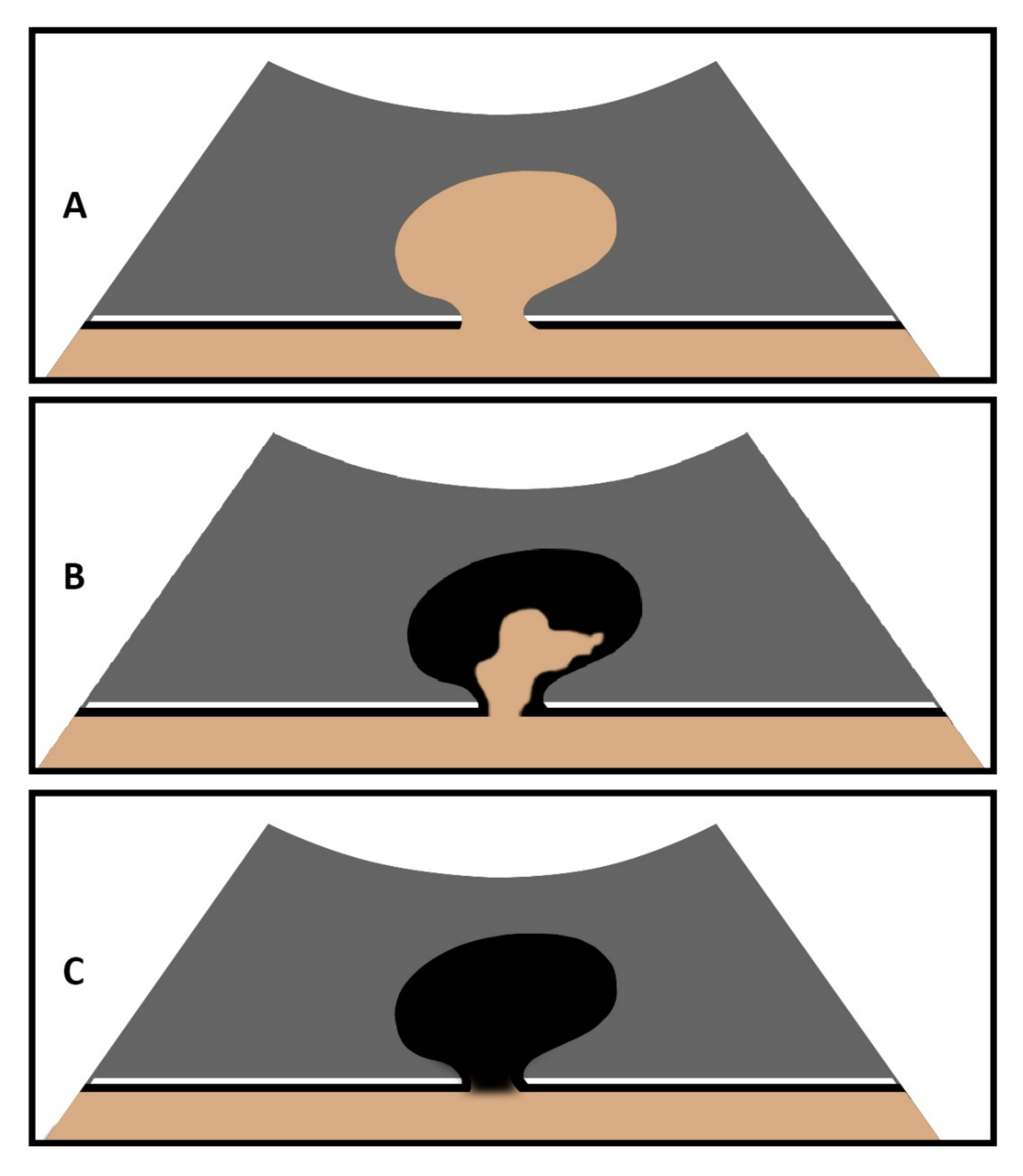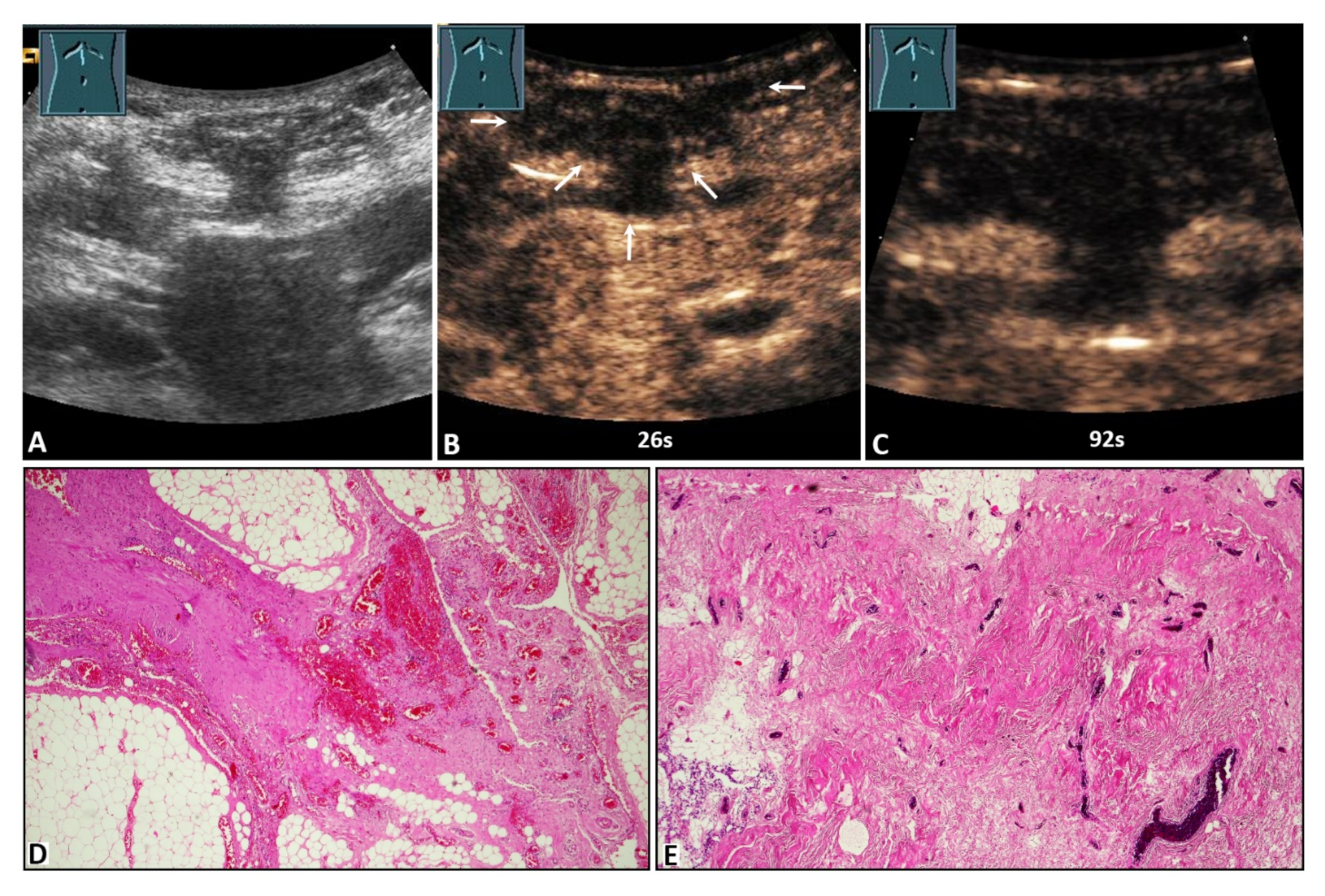The Value of Contrast-Enhanced Ultrasound (CEUS) in the Detection of Perfusion Disturbances in Abdominal Wall Hernias Compared with Surgical and Histological Assessment
Abstract
:1. Introduction
2. Materials and Methods
2.1. Ultrasound Data
- The hernia contents were classified as omentum or bowel by B-US. Hernia contents with an echogenic mass and without detection of bowel loops were defined as an omental hernia, and the clear detection of bowel loops with mixed echogenicity due to a reverberation artifact of air in the bowel loops was defined as an intestinal hernia [14,15]. The simultaneous presence of bowel and omentum was considered an intestinal hernia.
2.2. Surgical and Histopathological Evaluation
- Hernia contents were evaluated during surgical intervention and classified as omentum, bowel, or an empty sac.
- Macroscopic and microscopic confirmation or exclusion of non-perfused areas (NPAs) (necrosis, hemorrhage, and fibrosis) in hernia contents was conducted.
2.3. Statistical Analysis
3. Results
3.1. Demographic and Clinical Data
3.2. Ultrasound Data
3.3. Surgical Evaluation, Histopathological Examination, and Their Correlation with Ultrasound Data
4. Discussion
5. Conclusions
Author Contributions
Funding
Institutional Review Board Statement
Informed Consent Statement
Data Availability Statement
Acknowledgments
Conflicts of Interest
References
- Beadles, C.A.; Meagher, A.D.; Charles, A.G. Trends in Emergent Hernia Repair in the United States. JAMA Surg. 2015, 150, 194. [Google Scholar] [CrossRef] [PubMed]
- Sazhin, A.; Zolotukhin, I.; Seliverstov, E.; Nikishkov, A.; Shevtsov, Y.; Andriyashkin, A.; Tatarintsev, A.; Kirienko, A. Prevalence and risk factors for abdominal wall hernia in the general Russian population. Hernia 2019, 23, 1237–1242. [Google Scholar] [CrossRef] [PubMed]
- Ahmedalenazi, A.; Alsharif, M.M.; Hussain, M.A.; Gharbi Alenezi, N.; Alenazi, A.A.; Almadani, S.A.; Alanazi, N.H.; Alshammari, J.H.; Altimyat, A.O.; Alanazi, T.H. Prevalence, risk factors and character of abdominal hernia in Arar City, Northern Saudi Arabia in 2017. Electron. Physician 2017, 9, 4806–4811. [Google Scholar] [CrossRef]
- Dabbas, N.; Adams, K.; Pearson, K.; Royle, G. Frequency of abdominal wall hernias: Is classical teaching out of date? JRSM Short Rep. 2011, 2, 5. [Google Scholar] [CrossRef] [PubMed]
- Russell, T.B.; Elberm, H. Emergency hernia surgery at a high-volume tertiary centre: A 3-year experience. ANZ J. Surg. 2021, 91, 622–626. [Google Scholar] [CrossRef] [PubMed]
- Surek, A.; Gemici, E.; Ferahman, S.; Karli, M.; Bozkurt, M.A.; Dural, A.C.; Donmez, T.; Karabulut, M.; Alis, H. Emergency surgery of the abdominal wall hernias: Risk factors that increase morbidity and mortality—A single-center experience. Hernia 2021, 25, 679–688. [Google Scholar] [CrossRef]
- Koizumi, M.; Sata, N.; Kaneda, Y.; Endo, K.; Sasanuma, H.; Sakuma, Y.; Ota, M.; Lefor, A.T.; Yasuda, Y. Optimal timeline for emergency surgery in patients with strangulated groin hernias. Hernia 2014, 18, 845–848. [Google Scholar] [CrossRef]
- Sidhu, P.; Cantisani, V.; Dietrich, C.; Gilja, O.; Saftoiu, A.; Bartels, E.; Bertolotto, M.; Calliada, F.; Clevert, D.-A.; Cosgrove, D.; et al. The EFSUMB Guidelines and Recommendations for the Clinical Practice of Contrast-Enhanced Ultrasound (CEUS) in Non-Hepatic Applications: Update 2017 (Long Version). Ultraschall Med.—Eur. J. Ultrasound 2018, 39, e2–e44. [Google Scholar] [CrossRef]
- Safai Zadeh, E.; Kindermann, J.; Dietrich, C.F.; Görg, C.; Bleyl, T.; Alhyari, A.; Trenker, C. Clinical Awareness and Acceptance of Sonographically Diagnosed Epiploic Appendagitis (EA): A Retrospective Analysis of EA in a Single Tertiary Academic Referral Center. Ultrasound Int. Open 2020, 6, E87–E93. [Google Scholar] [CrossRef]
- Görg, C.; Egbring, J.; Bert, T. Contrast-enhanced ultrasound of epiploic appendagitis. Ultraschall Med. 2009, 30, 163–167. [Google Scholar] [CrossRef]
- Rosling, M.; Trenker, C.; Neesse, A.; Görg, C. Spontaneous and Traumatic Splenic Rupture: Retrospective Clinical, B-Mode and CEUS Analysis in 62 Patients. Ultrasound Int. Open 2018, 4, E30–E34. [Google Scholar] [CrossRef] [PubMed]
- Jung, E.M.; Stroszczynski, C.; Jung, F. Contrast enhanced ultrasonography (CEUS) to detect abdominal microcirculatory disorders in severe cases of COVID-19 infection: First experience. Clin. Hemorheol. Microcirc. 2020, 74, 353–361. [Google Scholar] [CrossRef] [PubMed]
- Heese, F.; Görg, C. Diagnostische Wertigkeit einer internistischen Referenzsonographie (DEGUM-Stufe 3). Ultraschall Med.—Eur. J. Ultrasound 2006, 27, 220–224. [Google Scholar] [CrossRef] [PubMed]
- Yang, D.M.; Kim, H.C.; Kim, S.W.; Won, K.Y. Groin abnormalities: Ultrasonographic and clinical findings. Ultrasonography 2020, 39, 166–177. [Google Scholar] [CrossRef]
- Trenker, C.; Dietrich, C.F.; Ziegler, E.; Neesse, A.; Görg, C. B-mode ultrasound and contrast-enhanced ultrasound (CEUS) of histological confirmed omental lesions: Retrospective analysis of n = 44 patients. Z. Gastroenterol. 2019, 57, 945–951. [Google Scholar] [CrossRef]
- Sartelli, M.; Coccolini, F.; van Ramshorst, G.H.; Campanelli, G.; Mandalà, V.; Ansaloni, L.; Moore, E.E.; Peitzman, A.; Velmahos, G.; Moore, F.A.; et al. WSES guidelines for emergency repair of complicated abdominal wall hernias. World J. Emerg. Surg. 2013, 8, 50. [Google Scholar] [CrossRef]
- Argintaru, N.; Al-Den, A.; Chenkin, J. Diagnosis of a Strangulated Laparoscopic Incisional Hernia with Point-of-Care Ultrasonography. West. J. Emerg. Med. 2015, 16, 450–452. [Google Scholar] [CrossRef]
- Rettenbacher, T.; Hollerweger, A.; Macheiner, P.; Gritzmann, N.; Gotwald, T.; Frass, R.; Schneider, B. Abdominal Wall Hernias. Am. J. Roentgenol. 2001, 177, 1061–1066. [Google Scholar] [CrossRef]
- Berney, C.R. Beware of spontaneous reduction “en masse” of inguinal hernia. Hernia 2015, 19, 995–997. [Google Scholar] [CrossRef]
- Morris-Stiff, G.; Hassn, A. Hernioscopy: A useful technique for the evaluation of incarcerated hernias that retract under anaesthesia. Hernia 2008, 12, 133–135. [Google Scholar] [CrossRef]
- Jancelewicz, T.; Vu, L.T.; Shawo, A.E.; Yeh, B.; Gasper, W.J.; Harris, H.W. Predicting strangulated small bowel obstruction: An old problem revisited. J. Gastrointest. Surg. 2009, 13, 93–99. [Google Scholar] [CrossRef] [PubMed]
- Jung, E.-M.; Weber, M.-A.; Wiesinger, I. Contrast-enhanced ultrasound perfusion imaging of organs. Der Radiol. 2021. [Google Scholar] [CrossRef] [PubMed]
- Piscaglia, F.; Nolsøe, C.; Dietrich, C.; Cosgrove, D.; Gilja, O.; Bachmann Nielsen, M.; Albrecht, T.; Barozzi, L.; Bertolotto, M.; Catalano, O.; et al. The EFSUMB Guidelines and Recommendations on the Clinical Practice of Contrast Enhanced Ultrasound (CEUS): Update 2011 on non-hepatic applications. Ultraschall Med.—Eur. J. Ultrasound 2011, 33, 33–59. [Google Scholar] [CrossRef] [PubMed]
- Bertolotto, M.; Derchi, L.E.; Sidhu, P.S.; Serafini, G.; Valentino, M.; Grenier, N.; Cova, M.A. Acute segmental testicular infarction at contrast-enhanced ultrasound: Early features and changes during follow-up. AJR Am. J. Roentgenol. 2011, 196, 834–841. [Google Scholar] [CrossRef]
- Miyoshi, T.; Okayama, H.; Hiasa, G.; Kawata, Y.; Yamada, T.; Kazatani, Y. Contrast-enhanced ultrasound for the evaluation of acute renal infarction. J. Med. Ultrason 2016, 43, 141–143. [Google Scholar] [CrossRef]
- Schwarze, V.; Lindner, F.; Marschner, C.; Negrão de Figueiredo, G.; Rübenthaler, J.; Clevert, D.A. Single-center study: The diagnostic performance of contrast-enhanced ultrasound (CEUS) for assessing focal splenic lesions compared to CT and MRI. Clin. Hemorheol. Microcirc. 2019, 73, 65–71. [Google Scholar] [CrossRef]
- Soldati, G.; Giannasi, G.; Smargiassi, A.; Inchingolo, R.; Demi, L. Contrast-Enhanced Ultrasound in Patients With COVID-19: Pneumonia, Acute Respiratory Distress Syndrome, or Something Else? J. Ultrasound Med. 2020, 39, 2483–2489. [Google Scholar] [CrossRef]
- Peradejordi Font, M.R.; Vas, D.; Trias Puigsureda, I.; Moreno Rojas, J.M.; Ribal Caparrós, M.J.; Nicolau Molina, C. The role of contrast enhanced ultrasound in the differential diagnosis of segmental testicular infarction. Radiol. Case Rep. 2021, 16, 3815–3820. [Google Scholar] [CrossRef]
- Fontanilla, T.; Noblejas, A.; Cortes, C.; Minaya, J.; Mendez, S.; Van den Brule, E.; Hernando, C.G.; Alfageme, M.; Baños, I.; Aguirre, E. Contrast-enhanced ultrasound of liver lesions related to arterial thrombosis in adult liver transplantation. J. Clin. Ultrasound 2013, 41, 493–500. [Google Scholar] [CrossRef]
- Higgins, D.F.; Kimura, K.; Bernhardt, W.M.; Shrimanker, N.; Akai, Y.; Hohenstein, B.; Saito, Y.; Johnson, R.S.; Kretzler, M.; Cohen, C.D.; et al. Hypoxia promotes fibrogenesis in vivo via HIF-1 stimulation of epithelial-to-mesenchymal transition. J. Clin. Investig. 2007, 117, 3810–3820. [Google Scholar] [CrossRef]





| Clinical Diagnosis | Number (%) |
|---|---|
| Inguinal hernia | 17 (34.0) |
| Incisional hernia | 15 (30.0) |
| Epigastric hernia | 9 (18.0) |
| Umbilical hernia | 7 (14.0) |
| Femoral hernia | 1 (2.0) |
| Spieghel’s hernia | 1 (2.0) |
| Contents of Hernia Sac | Bowel in Surgery 20/50 (40.0%) | Omentum in Surgery 25/50 (50.0%) | Empty in Surgery 5/50 (10.0%) |
|---|---|---|---|
| Bowel in ultrasound 23/50 (46.0%) | 20/23 (87.0%) | 1/23 (4.3%) | 2/23 (8.7%) |
| Omentum in ultrasound 27/50 (54.0%) | 0/27 (0.0%) | 24/27 (88.9%) | 3/27 (11.1%) |
| Clinical Diagnosis | NPAs on Surgical/Histopathological Examination 11/50 (22.0%) | No NPAs on Surgical/Histopathological Examination 39/50 (78.0%) |
|---|---|---|
| NEAs on CEUS 13/50 (34.0%) | 11/13 (84.6%) | 2/13 (15.4%) |
| No NEAs on CEUS37/50 (74.0%) | 0/37 (0.0%) | 37/37 (100.0%) |
| Imaging Modality | Cases | Year | Author | Sensitivity (%) | Specificity (%) |
|---|---|---|---|---|---|
| CDS | 149 | 2001 | Rettenbacher et al. [18] | 22.0 | 75.0 |
| CECT | 192 | 2009 | Jancelewicz et al. [21] * | 56.0 | 94.0 |
| CEUS | 50 | 2021 | Present study | 100.0 | 94.6 |
Publisher’s Note: MDPI stays neutral with regard to jurisdictional claims in published maps and institutional affiliations. |
© 2022 by the authors. Licensee MDPI, Basel, Switzerland. This article is an open access article distributed under the terms and conditions of the Creative Commons Attribution (CC BY) license (https://creativecommons.org/licenses/by/4.0/).
Share and Cite
Safai Zadeh, E.; Görg, C.; Kuttkat, P.; Dietrich, C.F.; Westhoff, C.C.; Rodepeter, F.; Trenker, C.; Görg, M.; Kirschbaum, A.; Alhyari, A. The Value of Contrast-Enhanced Ultrasound (CEUS) in the Detection of Perfusion Disturbances in Abdominal Wall Hernias Compared with Surgical and Histological Assessment. Diagnostics 2022, 12, 370. https://doi.org/10.3390/diagnostics12020370
Safai Zadeh E, Görg C, Kuttkat P, Dietrich CF, Westhoff CC, Rodepeter F, Trenker C, Görg M, Kirschbaum A, Alhyari A. The Value of Contrast-Enhanced Ultrasound (CEUS) in the Detection of Perfusion Disturbances in Abdominal Wall Hernias Compared with Surgical and Histological Assessment. Diagnostics. 2022; 12(2):370. https://doi.org/10.3390/diagnostics12020370
Chicago/Turabian StyleSafai Zadeh, Ehsan, Christian Görg, Phillip Kuttkat, Christoph Frank Dietrich, Christina Carolin Westhoff, Fiona Rodepeter, Corinna Trenker, Marvin Görg, Andreas Kirschbaum, and Amjad Alhyari. 2022. "The Value of Contrast-Enhanced Ultrasound (CEUS) in the Detection of Perfusion Disturbances in Abdominal Wall Hernias Compared with Surgical and Histological Assessment" Diagnostics 12, no. 2: 370. https://doi.org/10.3390/diagnostics12020370
APA StyleSafai Zadeh, E., Görg, C., Kuttkat, P., Dietrich, C. F., Westhoff, C. C., Rodepeter, F., Trenker, C., Görg, M., Kirschbaum, A., & Alhyari, A. (2022). The Value of Contrast-Enhanced Ultrasound (CEUS) in the Detection of Perfusion Disturbances in Abdominal Wall Hernias Compared with Surgical and Histological Assessment. Diagnostics, 12(2), 370. https://doi.org/10.3390/diagnostics12020370






